Horizontal and Vertical Voice Directivity Characteristics of Sung Vowels in Classical Singing
Abstract
:1. Introduction
- the effects of vocal range (voice type) on voice directivity characteristics,
- the effects of mouth opening in regard to pitch and vowel,
- vowel specific radiation characteristics for classical singers in the horizontal and vertical plane,
- the influence of the phonation mode on voice directivity characteristics.
2. Materials and Methods
2.1. Measurement System
2.2. Room Conditions
2.3. Double Circle Microphone Array
2.4. Mouth Tracking
2.5. Augmented Acoustics
2.6. Dataset
2.7. Calculation of Directivity Characteristics
2.8. Directivity Patterns
2.9. Directivity Index
2.10. Beam Width of the Energy Vector
3. Results and Discussion
3.1. Effects of Vocal Range
3.2. Effects of Pitch on Mouth Opening
3.3. Beam Width and Directivity Index for Female Singers
3.4. Beam Width and Directivity Index for Male Singers
3.5. Voice Directivity Characteristics and Phonation Mode
4. Conclusions
Author Contributions
Funding
Institutional Review Board Statement
Informed Consent Statement
Data Availability Statement
Acknowledgments
Conflicts of Interest
Abbreviations
| HDI | Horizontal directivity index |
| VDI | Vertical directivity index |
| IQR | Inter-quartile range |
| DCMA | Double circle microphone array |
| LTAS | Long-term averaged spectra |
| pd | Pure Data |
| Energy vector |
Appendix A
| v1 | v2 | a | h | c1 | d1 | e1 | f1 | g1 | a1 | h1 | c2 | d2 | e2 | f2 | g2 | a2 |
|---|---|---|---|---|---|---|---|---|---|---|---|---|---|---|---|---|
| a | e | 0.9 0.9 | 0.9 0.8 | 0.7 0.5 | 0.6 0.4 | 0.5 0.4 | 0.4 0.1 | 0 0.5 | 0.1 1 | 0.8 0.5 | 0.9 0.2 | 0.8 0.6 | 0.2 0.1 | 0.3 0 | 0.1 0.2 | 0.4 0.5 |
| a | i | 0.4 0.1 | 0.6 0.2 | 0.5 0 | 0.3 0.1 | 0.9 0.1 | 0.3 0.6 | 0.7 0.5 | 0.7 0 | 0.7 0.4 | 0.6 0.5 | 0.3 0.1 | 0.1 0.3 | 0.1 0.1 | 0.4 0.4 | 0.3 0.8 |
| a | o | 1 1 | 1 1 | 0.9 1 | 0.9 1 | 0.9 1 | 0.9 1 | 0.9 1 | 0.8 0.8 | 0.4 0.9 | 0.6 0.9 | 0.7 0.9 | 0.4 0.8 | 0.1 0.3 | 0.5 0.5 | 0.3 0.7 |
| a | u | 1 1 | 1 1 | 1 1 | 1 1 | 1 1 | 1 1 | 1 1 | 1 1 | 0.9 1 | 0.8 1 | 0.9 1 | 0.7 1 | 0.2 0.5 | 0.4 0.5 | 0.2 0.8 |
| e | i | 0.9 1 | 0.4 0.9 | 0.3 0.9 | 0.2 0.3 | 0.5 0.1 | 0.1 0.8 | 0.6 0.9 | 0.6 0.6 | 0.2 0.7 | 0 0.5 | 0.4 0.6 | 0.3 0.5 | 0.1 0.1 | 0.4 0.2 | 0.1 0.3 |
| e | o | 1 1 | 1 1 | 1 1 | 1 1 | 0.9 1 | 0.9 1 | 0.7 1 | 0.8 1 | 0.8 0.9 | 1 1 | 0.9 1 | 0.6 0.9 | 0.3 0.4 | 0.3 0.4 | 0.3 0.2 |
| e | u | 1 1 | 1 1 | 1 1 | 1 1 | 1 1 | 1 1 | 1 1 | 1 1 | 1 1 | 1 1 | 1 1 | 0.6 0.9 | 0.1 0.5 | 0.4 0.4 | 0.3 0.3 |
| i | o | 1 1 | 1 1 | 1 1 | 1 1 | 1 1 | 1 1 | 1 0.9 | 1 1 | 0.7 0.7 | 0.9 0.6 | 0.6 0.6 | 0.4 0.7 | 0.2 0.3 | 0.5 0.3 | 0.2 0 |
| i | u | 1 1 | 1 1 | 1 1 | 1 1 | 1 1 | 1 1 | 1 1 | 1 1 | 1 1 | 1 1 | 0.8 1 | 0.4 0.8 | 0 0.6 | 0.5 0.3 | 0 0.2 |
| o | u | 1 1 | 1 0.9 | 0.9 0.9 | 0.9 1 | 0.9 0.9 | 0.9 0.9 | 0.8 1 | 0.8 0.9 | 0.6 1 | 0.4 0.9 | 0.6 0.9 | 0.1 0.1 | 0.1 0.6 | 0.1 0.2 | 0.1 0.4 |
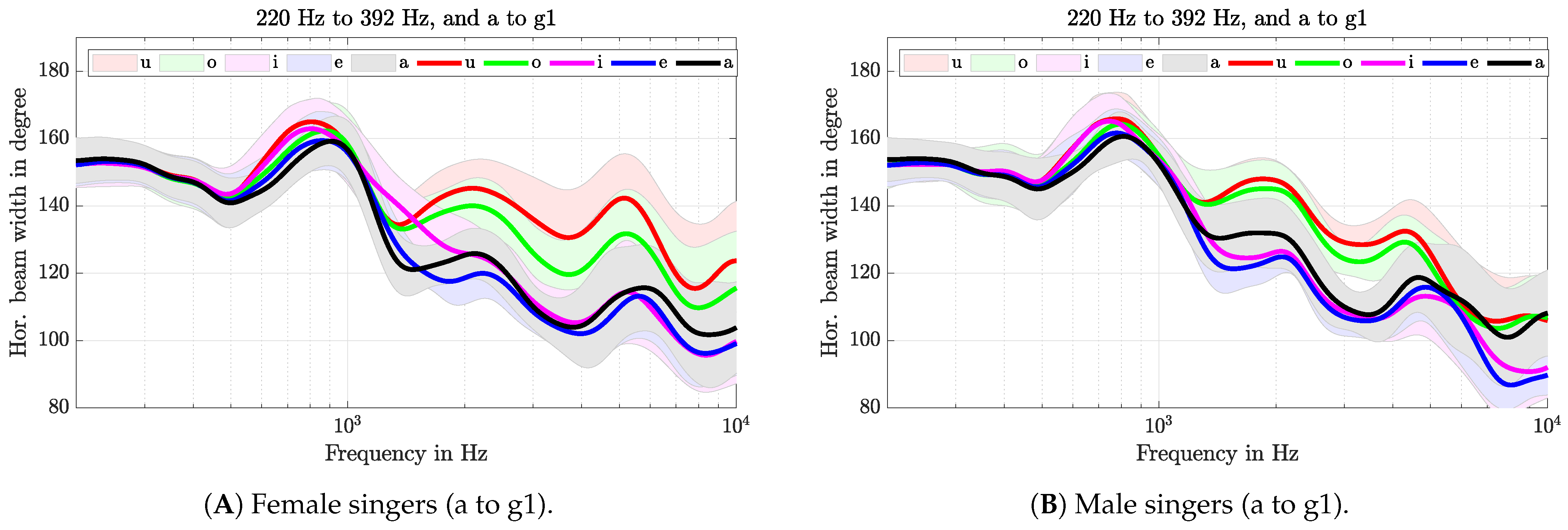
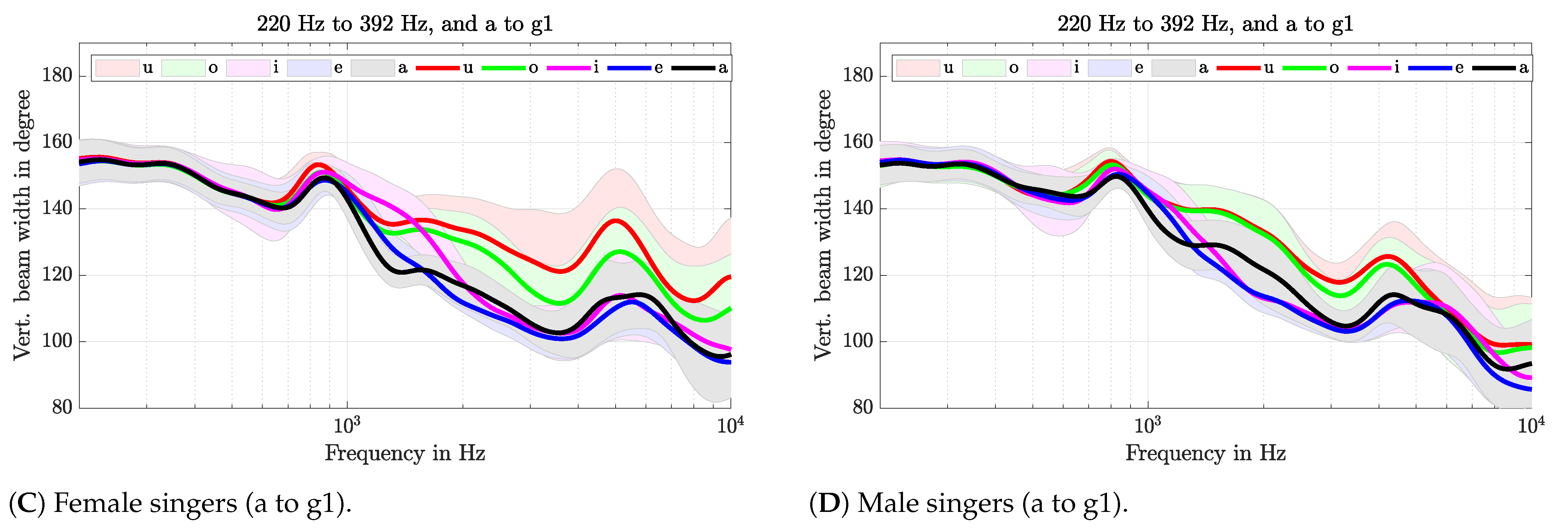
| v1 | v2 | a | h | c1 | d1 | e1 | f1 | g1 | a1 | h1 | c2 | d2 | e2 | f2 | g2 | a2 |
|---|---|---|---|---|---|---|---|---|---|---|---|---|---|---|---|---|
| a | e | 0.3 0.1 | 0.1 0.4 | 0.2 0.2 | 0.1 0.1 | 0.3 0.3 | 0.6 0.3 | 0.3 0.2 | 0.5 0 | 0.3 0.7 | 0.1 0.6 | 0.1 0.6 | 0.6 0.2 | 0.7 0.6 | 0.2 0.1 | 0.6 0.1 |
| a | i | 0.2 0.6 | 0.2 0.2 | 0 0.2 | 0 0.2 | 0.3 0.4 | 0.1 0.3 | 0.3 0.6 | 0 0.2 | 0.1 0.3 | 0.1 0.5 | 0.5 0.4 | 0.7 0.2 | 0.6 0.3 | 0.3 0.1 | 0.6 0.1 |
| a | o | 1 0.9 | 0.9 1 | 1 1 | 0.9 0.9 | 0.5 0.5 | 0.9 0.8 | 0.9 0.6 | 0.9 0.7 | 0.9 0.7 | 0.9 0.4 | 1 0.5 | 0.7 0.3 | 0.4 0.4 | 0.5 0.3 | 0.4 0.1 |
| a | u | 1 1 | 1 1 | 1 0.9 | 1 1 | 0.6 0.6 | 1 1 | 1 1 | 1 1 | 1 0.5 | 1 0.6 | 1 0.9 | 0.8 0.4 | 0.8 0.1 | 0.1 0 | 0.2 0.2 |
| e | i | 0.7 0.9 | 0.2 0.8 | 0.1 0.5 | 0.2 0.1 | 0.5 0.4 | 0.6 0.7 | 0.5 0.7 | 0.5 0.6 | 0.1 0.1 | 0.1 0.3 | 0.5 0.7 | 0.7 0.2 | 0.1 0.2 | 0.4 0.2 | 0.2 0.1 |
| e | o | 1 1 | 1 0.9 | 1 0.9 | 1 0.8 | 0.3 0.4 | 0.5 0.7 | 0.4 0.7 | 0.5 0.7 | 0.8 0.9 | 0.9 0.8 | 1 0.8 | 0.1 0.3 | 0.7 0.7 | 0.6 0.4 | 0.3 0 |
| e | u | 1 1 | 1 1 | 1 1 | 1 1 | 0.5 0.6 | 1 1 | 0.9 1 | 1 1 | 1 1 | 1 0.9 | 1 0.9 | 0.3 0 | 0.4 0.5 | 0.4 0.1 | 0.4 0.1 |
| i | o | 1 1 | 1 0.8 | 1 0.8 | 0.9 0.8 | 0.6 0.2 | 1 0.5 | 0.9 0.1 | 0.9 0.1 | 0.8 0.6 | 0.9 0.8 | 0.2 0.1 | 0.2 0.2 | 0.7 0.7 | 0.6 0.3 | 0.4 0 |
| i | u | 1 1 | 1 1 | 1 1 | 1 1 | 0.6 0.5 | 1 1 | 1 0.8 | 1 0.9 | 0.9 0.8 | 1 0.9 | 0.5 0.6 | 0.1 0.1 | 0.3 0.3 | 0.4 0 | 0.4 0.3 |
| o | u | 0.9 0.8 | 0.9 0.9 | 0.8 0.3 | 0.8 0.5 | 0.4 0.4 | 0.9 0.6 | 0.9 0.9 | 0.8 0.6 | 0.2 0.3 | 0.8 0.3 | 0.5 0.2 | 0.3 0.4 | 0.7 0.6 | 0.3 0.2 | 0.2 0.5 |
| v1 | v2 | H | c | d | e | f | g | a | h | c1 | d1 | e1 | f1 | g1 | a1 |
|---|---|---|---|---|---|---|---|---|---|---|---|---|---|---|---|
| a | e | 0.8 1 | 0.7 0.6 | 0.8 1 | 0.9 1 | 1 1 | 0.8 1 | 1 0.8 | 0.8 1 | 0.6 1 | 0.8 1 | 0.7 1 | 0.4 0.6 | 0.5 0.5 | 0.3 0.4 |
| a | i | 0.7 0.9 | 0.4 0.2 | 0.5 0.7 | 0.5 0.3 | 0.6 0.8 | 0.2 0.4 | 0.5 0.6 | 0.3 0.7 | 0.3 1 | 0.7 1 | 0.8 1 | 0.6 0.6 | 0.5 0.4 | 0.2 0.3 |
| a | o | 1 0.6 | 1 0.9 | 1 0.6 | 1 0.5 | 0.9 0.4 | 1 0.7 | 1 0.5 | 0.9 0.4 | 0.9 0.3 | 0.8 0.2 | 0.6 0.1 | 0.1 0.2 | 0.2 0.4 | 0 0.4 |
| a | u | 1 0.8 | 1 0.8 | 1 0.7 | 1 0.9 | 0.9 0.7 | 1 0.7 | 1 0.4 | 0.9 0.4 | 0.9 0 | 0.8 0.4 | 0.5 0.1 | 0 0.3 | 0 0.3 | 0.3 0.1 |
| e | i | 0.9 0.9 | 0.6 0.2 | 0.6 0.5 | 0.6 0.8 | 0.5 0.8 | 0.7 0.7 | 0.8 0.7 | 0.5 0.9 | 0.4 0.7 | 0.5 0.5 | 0.2 0.8 | 0.2 0.2 | 0.1 0 | 0.2 0.1 |
| e | o | 1 1 | 1 1 | 1 1 | 1 1 | 1 1 | 1 1 | 1 1 | 1 0.9 | 1 1 | 1 1 | 1 1 | 0.6 0.5 | 0.4 0.4 | 0.3 0.1 |
| e | u | 1 1 | 1 1 | 1 1 | 1 1 | 1 1 | 1 1 | 1 1 | 1 0.9 | 1 0.7 | 1 1 | 1 1 | 0.6 0.4 | 0.6 0.4 | 0.4 0.2 |
| i | o | 1 1 | 1 1 | 1 1 | 1 0.5 | 1 0.8 | 1 0.9 | 1 0.7 | 0.9 0.6 | 0.9 0.8 | 0.9 0.8 | 1 0.7 | 0.6 0.5 | 0.6 0.3 | 0.2 0.2 |
| i | u | 1 1 | 1 0.9 | 1 1 | 1 1 | 1 1 | 1 0.9 | 1 0.7 | 1 0.5 | 0.8 0.4 | 1 0.9 | 1 0.9 | 0.6 0.3 | 0.6 0.5 | 0.4 0.1 |
| o | u | 0.5 0.6 | 0.8 0.4 | 0.7 0.4 | 0.7 0.7 | 0.8 0.7 | 0.1 0 | 0.8 0 | 0.5 0 | 0.2 0 | 0.3 0.5 | 0.3 0.1 | 0 0.1 | 0.4 0 | 0.4 0.2 |
| v1 | v2 | H | c | d | e | f | g | a | h | c1 | d1 | e1 | f1 | g1 | a1 |
|---|---|---|---|---|---|---|---|---|---|---|---|---|---|---|---|
| a | e | 1 0.9 | 1 0.8 | 0.9 0.6 | 1 0.9 | 1 0.7 | 1 0.8 | 1 0.7 | 1 0.8 | 1 0.7 | 1 0.6 | 0.9 0.8 | 0.6 0.3 | 0.6 0.4 | 0.6 0.1 |
| a | i | 0.8 0.8 | 0.3 0.4 | 0.5 0.1 | 0.4 0.2 | 0.6 0.6 | 0.5 0.3 | 0.6 0.4 | 0.8 0.2 | 0.9 0.6 | 1 0.4 | 0.9 0.4 | 0.6 0.2 | 0.6 0.1 | 0.6 0.2 |
| a | o | 1 1 | 1 1 | 1 1 | 1 1 | 1 1 | 1 1 | 0.9 0.9 | 0.5 0.9 | 0.3 0.8 | 0.4 0.8 | 0.4 0.6 | 0.3 0.1 | 0.4 0.1 | 0.2 0.2 |
| a | u | 1 1 | 1 1 | 1 1 | 1 1 | 1 1 | 1 1 | 1 1 | 0.8 0.9 | 0.5 0.8 | 0.2 0.6 | 0.2 0.6 | 0.3 0.1 | 0.4 0.1 | 0.1 0.5 |
| e | i | 0.9 0.8 | 0.9 0.9 | 0.8 0.7 | 0.8 0.9 | 0.8 0.8 | 0.6 0.8 | 0.7 0.5 | 0.5 0.6 | 0.4 0.3 | 0.1 0.6 | 0 0.7 | 0.3 0.3 | 0.1 0.6 | 0 0.4 |
| e | o | 1 1 | 1 1 | 1 1 | 1 1 | 1 1 | 1 1 | 1 1 | 1 1 | 1 1 | 1 1 | 1 1 | 0.6 0.5 | 0.5 0.4 | 0.3 0.3 |
| e | u | 1 1 | 1 1 | 1 1 | 1 1 | 1 1 | 1 1 | 1 1 | 1 1 | 1 1 | 1 1 | 1 1 | 0.5 0.5 | 0.5 0.4 | 0.3 0.4 |
| i | o | 1 1 | 1 1 | 1 1 | 0.9 1 | 0.9 1 | 1 1 | 0.9 0.9 | 0.9 1 | 1 0.9 | 1 0.9 | 1 1 | 0.6 0.2 | 0.5 0.3 | 0.2 0.1 |
| i | u | 1 1 | 1 1 | 1 1 | 1 1 | 1 1 | 1 1 | 1 1 | 1 1 | 1 0.9 | 1 0.9 | 1 1 | 0.6 0.3 | 0.5 0.2 | 0.3 0.3 |
| o | u | 0.9 1 | 0.9 0.8 | 0.9 0.8 | 0.7 0.6 | 0.8 0.8 | 0.4 0.6 | 0.6 0.7 | 0.7 0.3 | 0.3 0.2 | 0.2 0 | 0.2 0.3 | 0.2 0.4 | 0.1 0.1 | 0.2 0.6 |
References
- Flanagan, J.L. Analog Measurements of Sound Radiation from the Mouth. J. Acoust. Soc. Am. 1960, 32, 1613–1620. [Google Scholar] [CrossRef]
- Huopaniemi, J.; Kettunen, K.; Rahkonen, J. Measurement and modeling techniques for directional sound radiation from the mouth. In Proceedings of the 1999 IEEE Workshop on Applications of Signal Processing to Audio and Acoustics, WASPAA’99 (Cat. No.99TH8452), New Paltz, NY, USA, 20–20 October 1999; pp. 183–186. [Google Scholar]
- Halkosaari, T.; Vaalgamaa, M.; Karjalainen, M. Directivity of Artificial and Human Speech. J. Audio Eng. Soc. 2005, 53, 620–631. [Google Scholar]
- Chu, W.T.; Warnock, A.C. Detailed Directivity of Sound Fields Around Human Talkers; Technical report-NRC-CNRC Publications Archive; National Research Council Canada: Ottawa, ON, Canada, 2002.
- Monson, B.B.; Hunter, E.J.; Story, B.H. Horizontal directivity of low- and high-frequency energy in speech and singing. J. Acoust. Soc. Am. 2012, 132, 433–441. [Google Scholar] [CrossRef] [PubMed] [Green Version]
- Kocon, P.; Monson, B.B. Horizontal directivity patterns differ between vowels extracted from running speech. J. Acoust. Soc. Am. 2018, 144, EL7–EL12. [Google Scholar] [CrossRef] [Green Version]
- Pörschmann, C.; Arend, J.M. Investigating phoneme-dependencies of spherical voice directivity patterns. J. Acoust. Soc. Am. 2021, 149, 4553–4564. [Google Scholar] [CrossRef]
- Marshall, A.H.; Meyer, J. The directivity and auditory impressions of singers. Acta Acust. United Acust. 1985, 58, 130–140. [Google Scholar]
- Kob, M.; Jers, H. Directivity measurement of a singer. J. Acoust. Soc. Am. 1999, 105, 1003. [Google Scholar] [CrossRef]
- Cabrera, D.; Davis, P.J. Vocal directivity measurements of eight opera singers. In Proceedings of the 18th International Congress on Acoustics, Kyoto, Japan, 4–9 April 2004; pp. 505–506. [Google Scholar]
- Katz, B.; D’Alessandro, C. Directivity Measurements of the Singing Voice. In Proceedings of the 19th International Congress on Acoustics, Madrid, Spain, 2–7 September 2007; pp. 45–50. [Google Scholar]
- Cabrera, D.; Davis, P.J.; Connolly, A. Long-term horizontal vocal directivity of opera singers: Effects of singing projection and acoustic environment. J. Voice 2011, 25, e291–e303. [Google Scholar] [CrossRef]
- Boren, B.B.; Roginska, A. Sound radiation of trained vocalizers. Proc. Meet. Acoust. 2013, 19, 035025. [Google Scholar]
- Blandin, R.; Brandner, M. Influence of the vocal tract on voice directivity. In Proceedings of the 2019 23rd International Congress on Acoustics—ICA, Aachen, Germany, 9–13 September 2019; Deutsche Gesellschaft für Akustik e.V.: Berlin, Germany, 2019; pp. 1795–1801. [Google Scholar]
- Brandner, M.; Blandin, R.; Frank, M.; Sontacchi, A. A pilot study on the influence of mouth configuration and torso on singing voice directivity. J. Acoust. Soc. Am. 2020, 148, 1169–1180. [Google Scholar] [CrossRef]
- Molloy, C.T. Calculation of the Directivity Index for Various Types of Radiators. J. Acoust. Soc. Am. 1948, 20, 387–405. [Google Scholar] [CrossRef]
- Tylka, J.G.; Sridhar, R.; Choueiri, E. A database of loudspeaker polar radiation measurements. In Proceedings of the Audio Engineering Society Convention 139, New York, NY, USA, 29 October–1 November 2015. [Google Scholar]
- Gerzon, M.A. General metatheory of auditory localisation. In Audio Engineering Society Convention; Audio Engineering Society: New York, NY, USA, 1992. [Google Scholar]
- Kadiri, S.R.; Alku, P.; Yegnanarayana, B. Analysis and classification of phonation types in speech and singing voice. Speech Commun. 2020, 118, 33–47. [Google Scholar] [CrossRef]
- Zhang, Z. Mechanics of human voice production and control. J. Acoust. Soc. Am. 2016, 140, 2614–2635. [Google Scholar] [CrossRef] [Green Version]
- Brandner, M.; Frank, M.; Rudrich, D. DirPat—Database and viewer of 2D/3D directivity patterns of sound sources and receivers. In Proceedings of the Audio Engineering Society Convention 144, Milan, Italy, 23–26 May 2018. [Google Scholar]
- Frank, M.; Rudrich, D.; Brandner, M. Augmented practice-room—Augmented acoustics in music education. In Fortschritte der Akustik, DAGA; Deutsche Gesellschaft für Akustik: Berlin, Germany, 2020; pp. 151–154. [Google Scholar]
- Klanjscek, N.; David, L.; Frank, M. Evaluation of an e-learning tool for augmented acoustics in music education. Music Sci. 2021, 4, 20592043211037511. [Google Scholar] [CrossRef]
- Meyer-Kahlen, N.; Rudrich, D.; Brandner, M.; Wirler, S.; Windtner, S.; Frank, M. Diy modifications for acoustically transparent headphones. In Audio Engineering Society Convention 148; Audio Engineering Society: New York, NY, USA, 2020. [Google Scholar]
- Beranek, L.L. Concert hall acoustics—1992. J. Acoust. Soc. Am. 1992, 92, 1–39. [Google Scholar] [CrossRef]
- Skålevik, M. Reverberation Time—The mother of all room acoustic parameters. In Proceedings of the 20th International Congress on Acoustic, ICA, Sydney, Australia, 23–27 August 2010; Volume 10. [Google Scholar]
- Welch, P.D. The use of fast Fourier transform for the estimation of power spectra: A method based on time averaging over short, modified periodograms. IEEE Trans. Audio Electroacoust. 1967, 15, 70–73. [Google Scholar] [CrossRef] [Green Version]
- Zotter, F. Analysis and Synthesis of Sound-Radiation with Spherical Arrays. Ph.D. Thesis, University of Music and Performing Arts, Institute of Electronic Music and Acoustics, Graz, Austria, 2009. [Google Scholar]
- Barber, C.B.; Dobkin, D.P.; Huhdanpaa, H. The quickhull algorithm for convex hulls. ACM Trans. Math. Softw. 1996, 22, 469–483. [Google Scholar] [CrossRef] [Green Version]
- Wilcoxon, F. Individual comparisons by ranking methods. Biometrics 1945, 1, 196–202. [Google Scholar]
- Holm, S. A simple sequentially rejective multiple test procedure. Scand. J. Stat. 1979, 6, 65–70. [Google Scholar]
- Glass, G.V. Note on rank biserial correlation. Educ. Psychol. Meas. 1966, 26, 623–631. [Google Scholar] [CrossRef]
- Kerby, D.S. The Simple Difference Formula: An Approach to Teaching Nonparametric Correlation. Compr. Psychol. 2014, 3, 11-IT. [Google Scholar] [CrossRef]
- Cohen, J. Statistical Power Analysis for the Behavioral Sciences, 2nd ed.; Routledge: New York, NY, USA, 1988. [Google Scholar]
- Gregg, J.W.; Scherer, R.C. Vowel intelligibility in classical singing. J. Voice Off. J. Voice Found. 2006, 20, 198–210. [Google Scholar] [CrossRef] [PubMed]
- Ophaug, W. The diminished vowel space in classical singing and the tug of war between "speech-true" and modified vowel qualities. J. Sing. 2017, 73, 293–303. [Google Scholar]
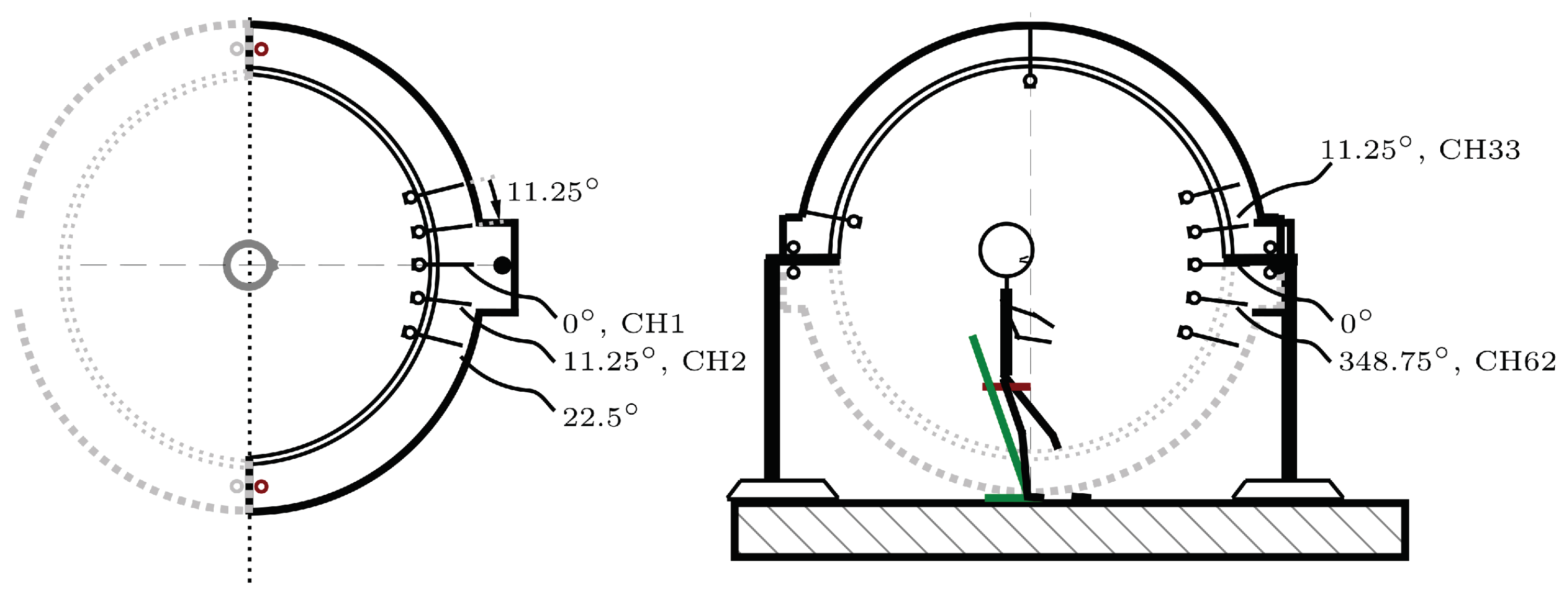
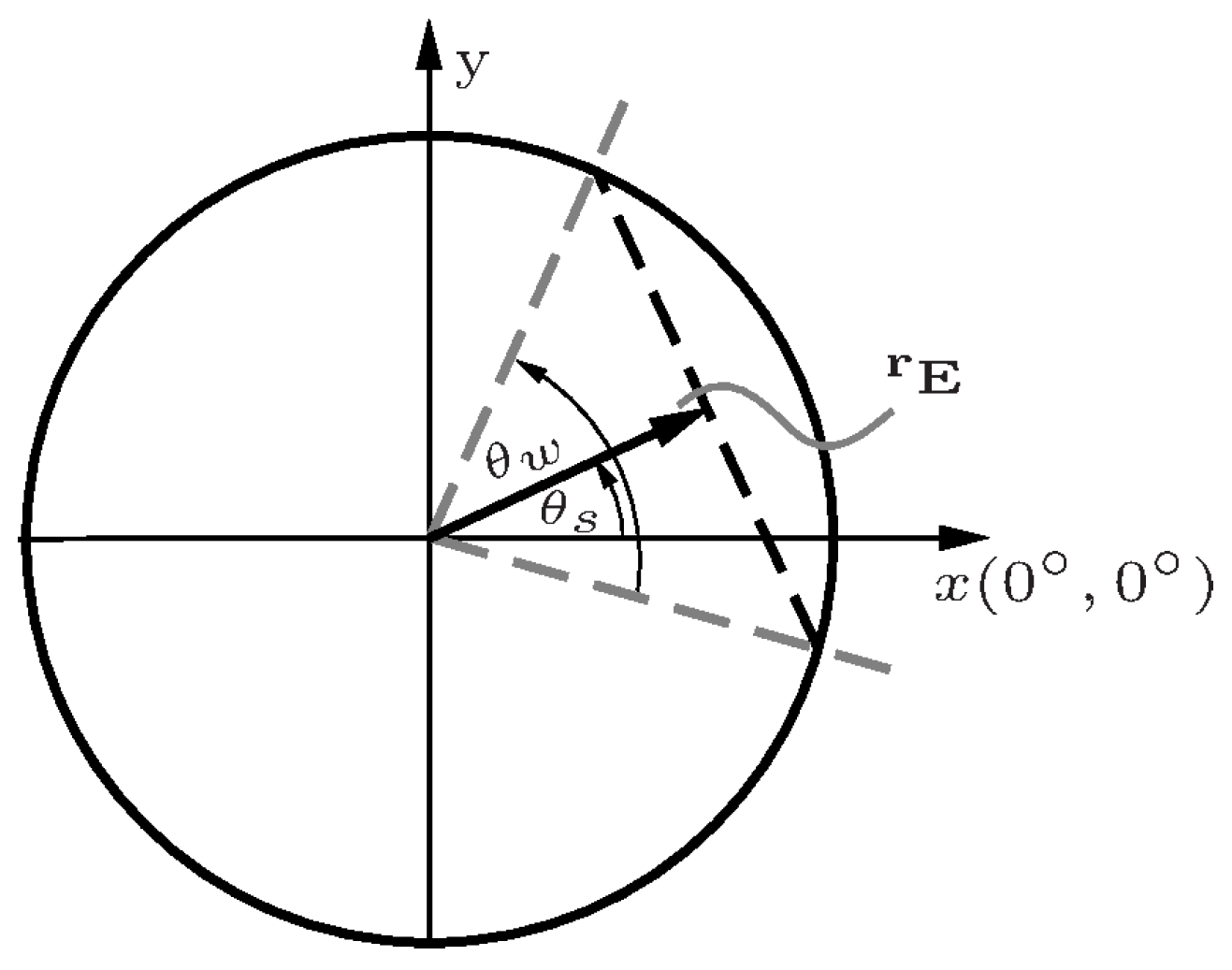

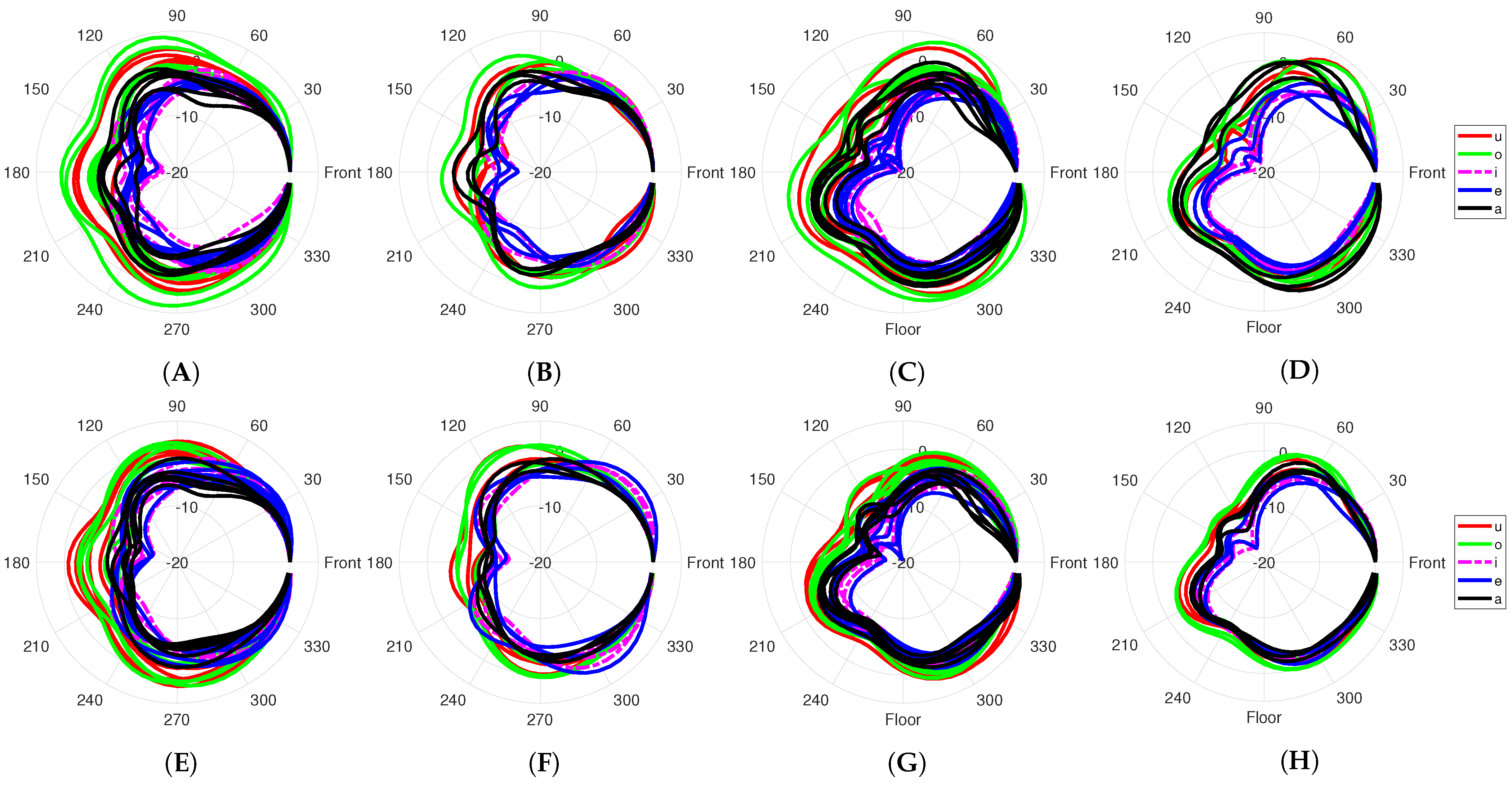







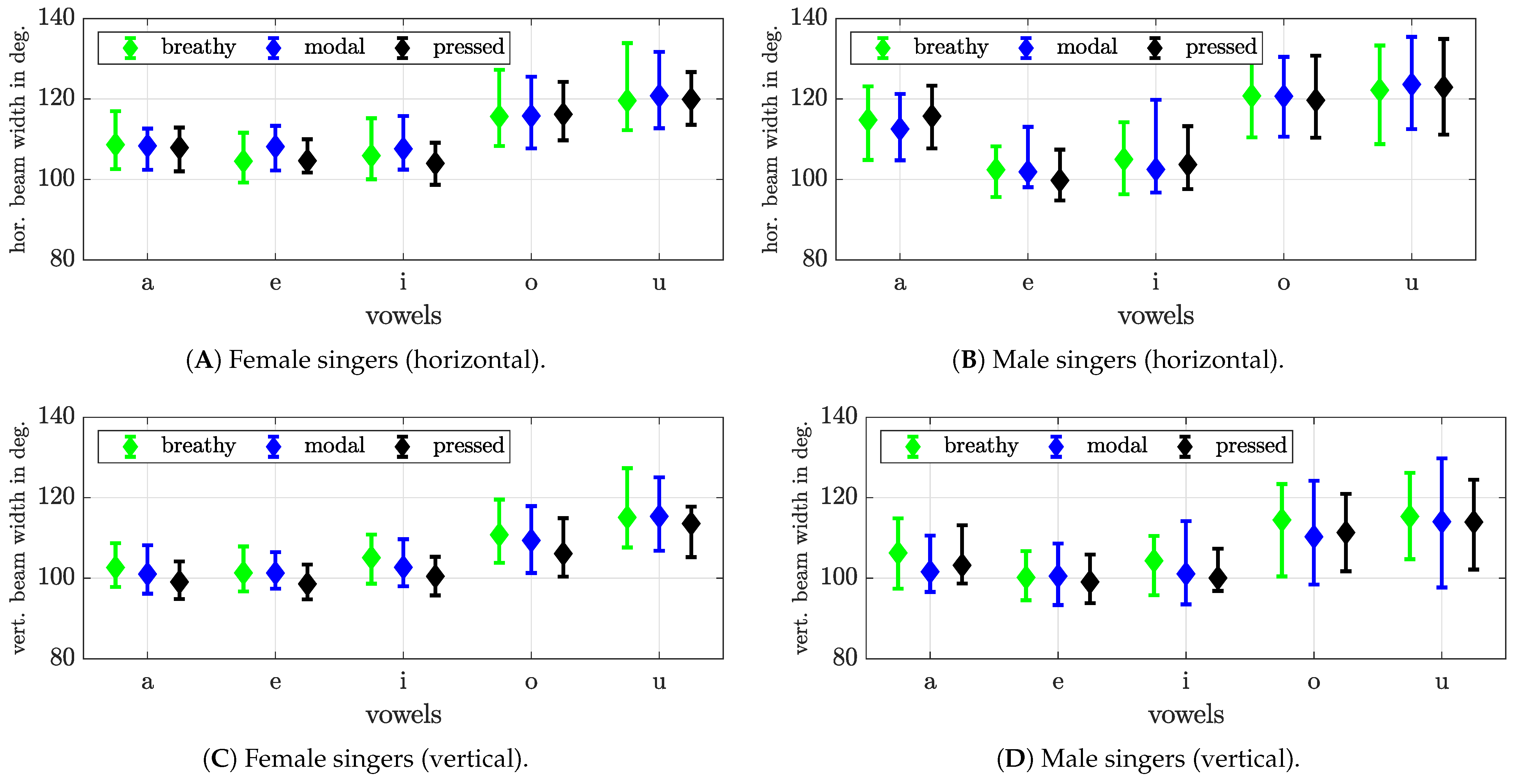
Publisher’s Note: MDPI stays neutral with regard to jurisdictional claims in published maps and institutional affiliations. |
© 2022 by the authors. Licensee MDPI, Basel, Switzerland. This article is an open access article distributed under the terms and conditions of the Creative Commons Attribution (CC BY) license (https://creativecommons.org/licenses/by/4.0/).
Share and Cite
Brandner, M.; Frank, M.; Sontacchi, A. Horizontal and Vertical Voice Directivity Characteristics of Sung Vowels in Classical Singing. Acoustics 2022, 4, 849-866. https://doi.org/10.3390/acoustics4040051
Brandner M, Frank M, Sontacchi A. Horizontal and Vertical Voice Directivity Characteristics of Sung Vowels in Classical Singing. Acoustics. 2022; 4(4):849-866. https://doi.org/10.3390/acoustics4040051
Chicago/Turabian StyleBrandner, Manuel, Matthias Frank, and Alois Sontacchi. 2022. "Horizontal and Vertical Voice Directivity Characteristics of Sung Vowels in Classical Singing" Acoustics 4, no. 4: 849-866. https://doi.org/10.3390/acoustics4040051
APA StyleBrandner, M., Frank, M., & Sontacchi, A. (2022). Horizontal and Vertical Voice Directivity Characteristics of Sung Vowels in Classical Singing. Acoustics, 4(4), 849-866. https://doi.org/10.3390/acoustics4040051






